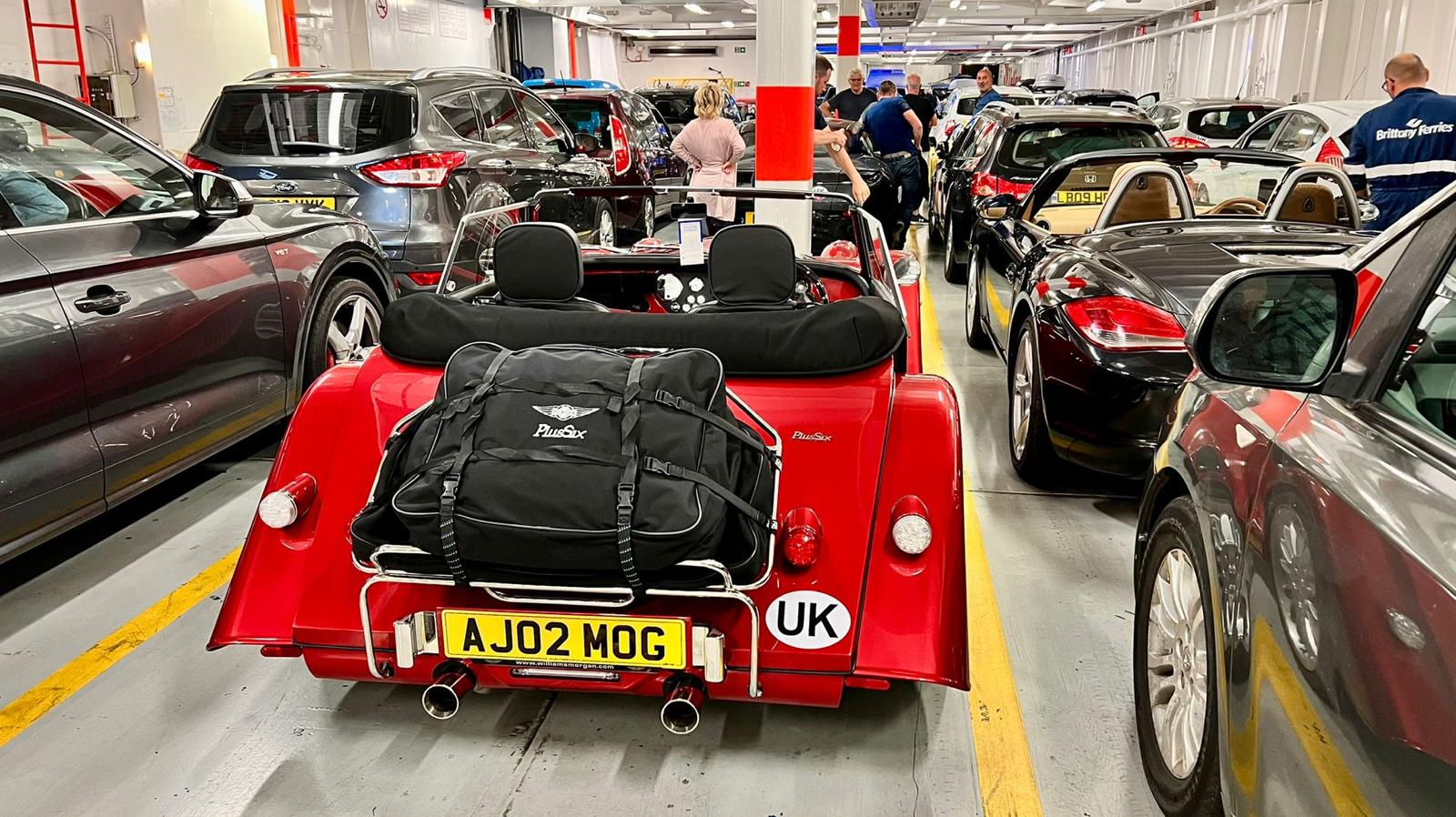
Take the ferry for a no-fly holiday to Spain and Portugal
Start and end your Spanish road-trip with a relaxing ferry cruise, the ideal solution for those tired of flying or those looking for a more eco-friendly holiday option. Northern Spain offers an exciting and low-carbon alternative to France for travellers who prefer not to fly.
Take a direct ferry to Northern Spain to enjoy surfy beaches, world-class cuisine, and soaring mountain scenery, straight off the ferry. As well as its famous gastronomy, the region boasts a rich heritage with stunning modern and ancient architecture, and much more. Discover sleepy fishing villages and lively cities, all within a predominantly rural and unspoiled area.
With excellent motorway connections, Santander and Bilbao are gateways to exploring all of Spain and Portugal by car. Embark on an epic journey to Porto, Toledo, or the Mediterranean coast, or stay closer to discover the charms of northwest Spain or the Spanish Pyrenees.
The roads are excellent, driving conditions are pleasant, and you’ll find plenty of delights to bring home in the boot, from Rioja and Ribera del Duero wines to fine Spanish ham, all at great prices!
- Ferries from UK to Spain – six crossings per week
- Ferries from Ireland to Spain – two crossings per week
- Is it cheaper to fly or ferry to Spain?
- Is taking the ferry to Spain greener than flying?
- How long does the ferry take to get to Spain?
- Taking my own car on the ferry to Spain vs flying down and renting a car
Preparing your car
Ferries from the UK to Spain – six crossings a week
Sail direct from Portsmouth or Plymouth to Santander or Bilbao
Brittany Ferries now offers six crossings a week from the UK to northern Spain.
Ferries depart from Portsmouth and Plymouth, arriving in Spain at either Bilbao or Santander.
The Spanish ports are only an hour apart, making it easy to include both in your travel plans (i.e. you can sail into one and back from the other).
All crossings are operated by Brittany Ferries.
Ferry services from Portsmouth routes are on the Galicia, Santoña and Salamanca – all new since 2020 and all running on environmentally friendly LNG.
Plymouth routes are on the Pont Aven – the ‘great dame’ of the Brittany Ferries fleet and still the most powerful ship they have.
Ferries from Ireland to Spain – two crossings a week
Sail direct from Rosslare to Bilbao
Brittany Ferries now offer two crossings a week from Rosslare to Bilbao using the brand-new Galicia and Santoña ships

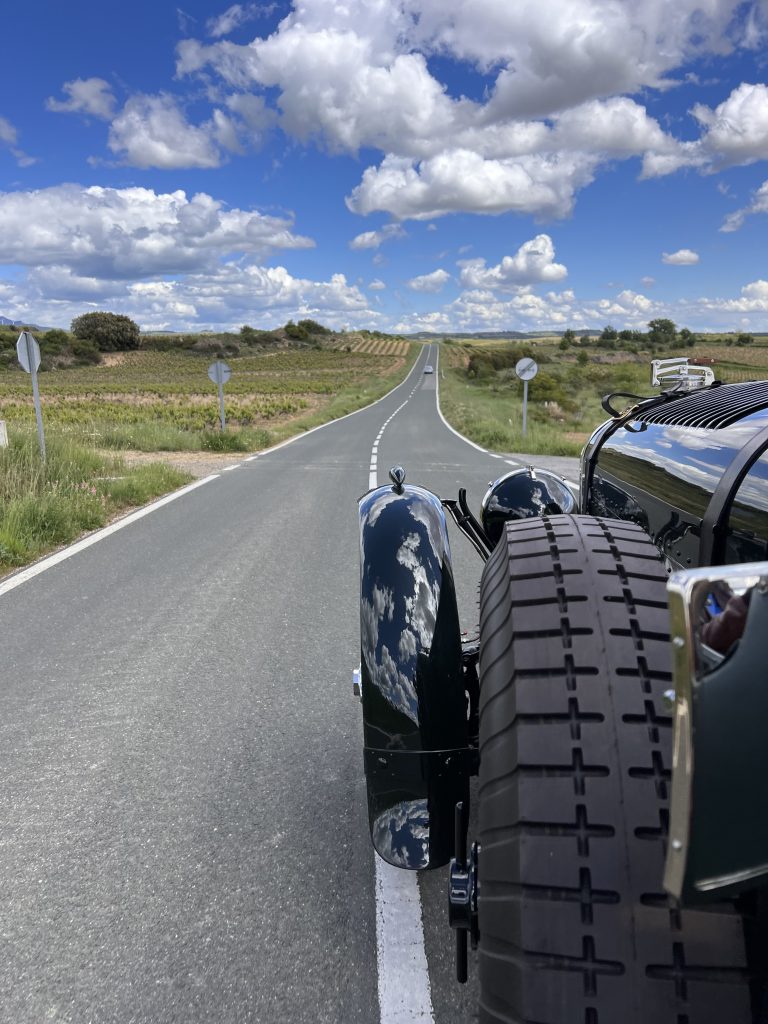
Is it cheaper to fly or take the ferry to Spain?
It depends…
Many clients ask if the ferry is more economical than flying direct to Spain – the answer depends on several factors:
How many people are travelling?
To calculate the total cost of each option we need to compare the price of the ferry ticket (of which the main component is the car and cabin – plus a small additional amount per passenger) with the cost of hiring a car plus return flights for each individual passenger.
We also need to factor in the size of the hire car. Economy and Compact class hire cars which are fine for two people are in abundance and relatively cheap – larger vehicles suitable for 3 or 4 people plus luggage are less common and can incur a significant cost increment.
In summary 2 people taking 2 return flights and renting a small car usually comes out cheaper than the equivalent ferry whilst 4 people, 4 flights and a large car can often be more expensive.
How long are you going for?
The ferry price is usually the same irrespective of how long you’ll spend in Spain & Portugal whilst the price of the hire car is per day, making a fly-drive holiday more expensive the longer you stay. A one-week holiday is nearly always going to work out more expensive by ferry whereas the ferry can be comparable or cheaper for stays of 10 to 14 nights.
How long is it till you travel?
Both ferries and flights operate on a ‘dynamic pricing’ model where fares rise as the dates approach and availability reduces but in general the flight model is more aggressive meaning that as dates approach the ferry option often becomes more favourable.
In the end it often comes down to personal preferences but we would generally advise against using the ferry for one-week holidays unless you don’t like flying or you’re keen to travel with a special car or motorbike.
If in doubt we’re happy to quote for both options so you can compare Ferry-drive vs Fly drive and make an informed decision.
Is taking the ferry to Spain more eco-friendly than flying?
What’s the CO2 footprint of the ferry compared with flying?
The good news is it’s a lot cleaner!
It can be difficult to get an exact handle on the numbers but in terms of CO2 emissions The Guardian puts it at around a third i.e. 90kg vs 280kg for an equivalent London-Bilbao flight – and that’s for Brittany Ferries traditional ships i.e. for Spanish sailings this is only applicable to the Pont Aven which operates the Plymouth – Santander route.
Since 2021 Brittany Ferries have introduced three new ships – the Galicia, Santoña and Salamanca – which are designed with fuel efficiency and the environment in mind. The Santoña and the Salamanca are LNG fueled which gives a saving of 20% in CO2 emissions which in addition mean that funnel emissions are sulphur-free, virtually particulate-free, with a 95% reduction in nitrogen dioxide.
How long does the ferry take to Spain
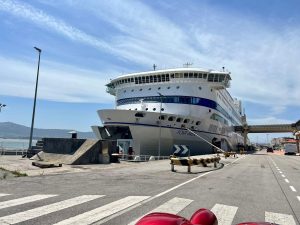
- Distance – Plymouth to Santander is just 480 nautical miles whilst Portsmouth to Bilbao is 660 nautical miles,
- Power of the ship – older boats like the Pont Aven were built with speed in mind whilst the newer ships have a clear focus on environmental considerations.
- Scheduling – Outbound sailings from Portsmouth are now scheduled as two-night crossings with the arrival in Spain at 8.00. Return sailings are one-night crossings so more direct and are generally 2 or 3 hours quicker.
To see the current timetables and more info about the ferry sailings please see our Ferry-Drive Tours page.
Taking my own car on the ferry to Spain vs flying down and renting a car?
The Pros and Cons of taking your car on the ferry to Spain
There are several pros and cons to taking your car on the ferry vs flying down and renting
Advantages
- It can be cheaper – for longer trips, more people and out of season travel the ferry can work out more economical – see above
- It’s more eco-friendly – see above
- You know the car – whilst it can be fun to try a new car on holiday there is certainly some comfort in having your own vehicle whilst travelling.
- It’s your special car – whilst basic rental cars are plentiful and cheap anything above a compact class (Ford Focus or similar) starts to become more pricey and harder to come by. If you’re used to driving something bigger or better at home it can lead to disappointment. If you have a classic or collectors’ car this can be a big factor in the decision.
- Avoid the hassles of car rental – though the pitfalls of car rental can be navigated – see our article on Avoiding Problems with Car Rental – by taking your own car you eliminate them totally
- Avoid the hassles of airports – another stress point of any fly-drive holiday
- Bring back a boot-full of goodies! though the duty free allowance is somewhat reduced since Brexit you can still stock up on wonderful goodies like Spanish jamón, chorizo, tuna, and perhaps a few bottles of selected wines…
Disadvantages
- It can be more expensive – see above – though this can be offset by the boot-full of goodies
- It’s definitely slower – see above – but isn’t slow-travel all the rage now?
- The steering wheel is on the wrong side – this can be a serious disadvantage and needs to be considered. Overtaking on country roads can be hazardous and even impossible at times – then again you’re on holiday, so what’s the rush?
- When things go wrong it’s your car – this also needs serious consideration and it’s imperative that you take out international insurance and high quality international breakdown cover.
Do I need a ‘green card’ to drive my car in Spain and Portugal?
No but…
According to gov.uk website All UK vehicle insurance provides the minimum third party cover to drive in the EU (including Ireland)
But you should ‘check with your insurer if your policy has extra cover for things like theft or damage to your car abroad’.
No green card required.
Do I need international breakdown cover to drive in Spain and Portugal?
Not a legal requirement – but yes…
Whilst international breakdown cover isn’t a legal requirement for driving in Spain and Portugal we would highly recommend taking out a good quality policy before travel.
If you break down in Spain or Portugal without cover, getting help or having the car sent home can be very expensive indeed.
If you don’t know the language it can be extremely stressful and, whilst Casas Cantabricas can help with communications when small issues arise or to help you through a crisis, a good cover including repairs towing, replacement vehicle etc is absolutely essential when things go more seriously wrong.
Preparing your car – before you travel
Principally you need to ensure tat you carry the following items: driving licence (international licence not required), Vehicle insurance, Vehicle registration document, UK sticker, Warning triangle (x2) and reflective jacket.
For more detailed information please refer to our partner Brittany Ferries’ excellent pages on Driving in Spain and Driving in Portugal
Requirements are similar for the two countries though in Portugal it’s necessary to prepare for the toll system and helpful to register in advance.
Tolls in Portugal
Easy Toll
Register your car with the Portuguese ‘Easy Toll’ system (see link below) before you leave the UK. It’s quite simple, you just need to associate your credit card with your number plate. Registration is valid for 30 days (which needs to cover you stay in Portugal).
https://www.portugaltolls.com/en
Or you can register at the border:
Where to access: Welcome Points located at the border posts at the following locations EN13 – Vila Nova de Cerveira, A24-Chaves, A25 – Vilar Formoso and A22 – Vila Real de Santo António.
How to access: The driver, not having to leave the vehicle, enters the credit card in the payment terminal and the system automatically associates the vehicle’s license plate to the bankcard. The tolls rates owed are directly debited to the account associated with the card. Validity: At the time of accession, valid for 30 days, a ticket is issued as proof and must be kept.
PLEASE NOTE – this covers the automatic gantry tolls found on most motorways but NOT the Via Verde tolls (found near large cities) where you will find barriers and have to pay with cash or card in the traditional way.
On the road in Spain and Portugal
Driving in Spain and Portugal – all you need to know
Firstly we would once again refer you to our Partner Brittany Ferries excellent pages on Driving in Spain and Driving in Portugal
Driving is generally quite civilised and traffic density is very low, compared to the UK.
Obviously in Spain and Portugal they drive on the right but otherwise the driving rules and conditions are very similar.
Roundabouts
One difference to look out for is in the use of roundabouts which was recently clarified by the DGT basically the inner lane should only be used for overtaking (instead of , as habitually the case in the UK, using it to take the right turn). The safest bet is always to enter and stay in the outer, right-hand, lane irrespective of which exit you’ll be taking.
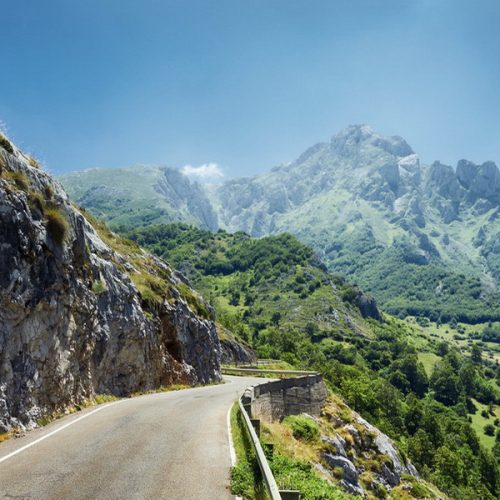
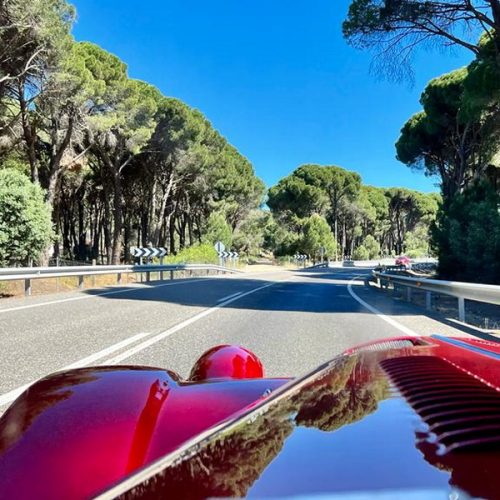
A few sample tours
Trust the experts
At Casas Cantabricas we’ve been working with Brittany Ferries’ Spanish crossings now for nearly 40 years.
We have a wide selection of ferry-drive trips designed to fit perfectly with the Brittany Ferries sailings and are happy to tailor all of our trips to suit our particular needs.
If you’re thinking about bringing your classic car to Spain and Portugal we have a wealth of experience both with individual travellers and groups.
Likewise we have for many years been helping those who wish to bring their motorcycle to Spain and Portugal with their touring plans – both for groups and individuals.

